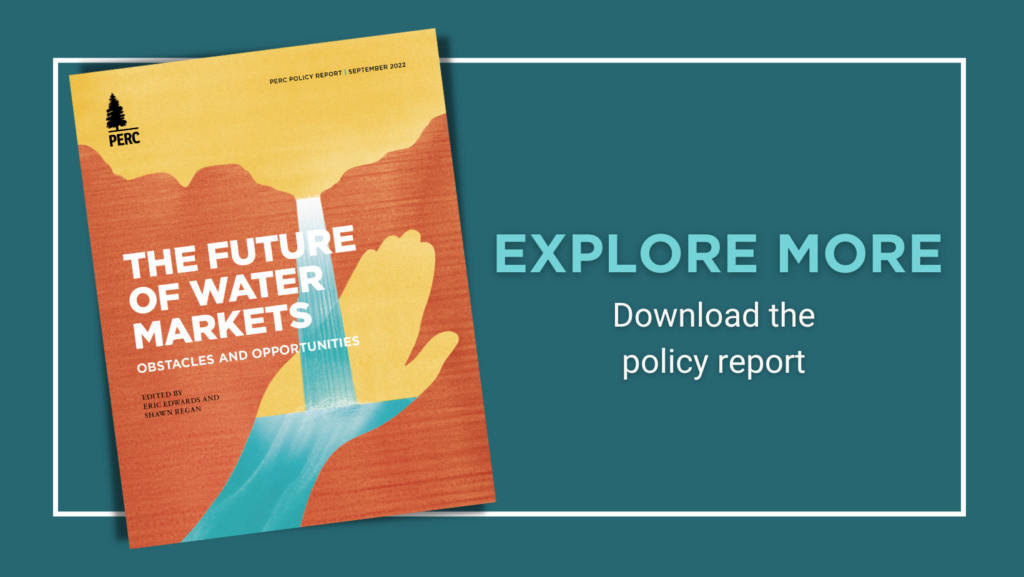This postscript is part of a volume entitled “The Future of Water Markets: Obstacles and Opportunities,” published by PERC, which addresses timely water policy issues and offers ideas to enhance the future of water markets.
Unlike water, there is no shortage of dire warnings of climate change and threats to the amount, quality, location, and timing of freshwater availability. Temperatures are predicted to be higher, precipitation to be more variable across space and time, and severe drought to be more common. Water scarcity will increase. Competition among urban populations, agricultural producers, the energy sector, and environmental protection will intensify.
Despite all of this, the actual economic and social effects of increased water scarcity depend importantly upon the institutional response: centralized government regulation or water markets. The efficacy of each approach is very different. For most of the world, the decision already has been made. Freshwater is owned and managed by the state. In some parts, however, especially the semi-arid western United States, private water rights exist, and water markets are operating. If and how they expand to meet climate change depends upon political support and mitigating the negative effects of moving water. Agricultural communities that have historically used 60 to 80 percent of available water will almost certainly lose water, and they are up in arms.
The media highlights their concerns with the popular David-versus-Goliath narrative: Private buyers strip a region of its water, leave it “high and dry,” ship the water elsewhere, and get rich. Local economies and the natural environment are devastated. Appeals are made to politicians and regulatory agency officials, as well as to advocacy groups that seek access to water via political mandates. These joint efforts block water market trades or so constrain them that their effectiveness is undermined. Addressing the concerns of rural communities directly can blunt political opposition, confront perceived equity and ecological effects, and advance water markets.
As a basis for comparison of outcomes, consider the two institutional options for responding to climate change and water availability. First, consider regulatory responses. Where tradable water rights do not exist, water is effectively a common-pool resource by law. Government agencies determine how water is distributed across sectors and regions; mandate water conservation via restrictions on access, use, and timing; and make investments in infrastructure for water storage and allocation. The political and bureaucratic decisions are molded by constituent-group objectives, including those of agency staffs. Motivated by political agendas that may or may not overlap with overall welfare, politicians, bureaucrats, and administrative judges proceed without reliable information on relative values of water uses and conservation options across time and locations. Serious misallocation can result. The process is crisis-driven, which assists lobby-group mobilization; responses are lumpy and not flexible. Once water policies are implemented, groups have a stake in maintaining them, even if they do not advance overall welfare. Inefficiencies create their own constituencies. In light of new climatic conditions and shifts in water scarcity and values, regulatory responses take place within the established framework. There is no obvious mechanism for flexible, smooth reactions as circumstances change.
Given the recent experience with Covid regulations, it is easy to predict that some forms of agriculture, industrial production, urban use, and environmental protection will be deemed “essential” and get water access, whereas other allocations will be constrained. Regulation of demand entails mandated water conservation via greywater recycling, installation of low-flush toilets, limitations on landscape irrigation and other related “discretionary, but not essential” water uses. Mandates will determine agricultural crops and irrigation practices. In light of evasion incentives, compliance requires observation and monitoring of the use of so basic a commodity as water. These actions may or may not impact overall water consumption or pass any conventional cost-benefit analysis. In urban areas, the price of housing rises and water access is constrained, especially by the poor who consume a greater share of their incomes than do the rich. In rural areas, the value of agricultural output and employment fall.
Second, consider water markets. Despite common perceptions, water markets provide a more socially favorable outcome. Where freshwater is privately owned and tradable, it can be reallocated incrementally from lower- to higher-valued uses as new scarcity information emerges. The trading process generates additional information as users learn about options for water in competing settings and times. This information is an incredibly valuable public good. It encourages incremental adjustments in consumption, investment, and distribution. In light of the uncertainty associated with climate change and water, modifications can be made as additional evidence appears, raising both private and social returns. The market process both generates and responds to water-climate information. A crisis is not needed, and indeed can be avoided.
Untapped Markets
The western United States is fortunate to have the alternative of private water rights and markets, but they are controversial and often take a back seat to government actions. Why is that?
One reason is philosophical. Water is viewed by many as inherently a public (common-pool) resource so vital that it cannot be owned privately. This view is prevalent in much of the world, where water is already a state asset with incumbent regulators and aligned constituencies. For example, Pedro Arrojo-Agudo of the U.N. Human Rights Commission asserted in 2020 that “Water belongs to everyone and is a public good.” He claimed that it is too essential to be delegated to private parties and markets. Unfortunately, the opposite is more apt to be the case.
The rejection of water market trades as a means of addressing growing shortfalls between freshwater supply and demand leaves no clear mechanism for adjustment. Moreover, there are no general comparisons of the outcomes of regulatory responses versus water markets. There is scattered evidence that political objectives and related subsidies in agriculture undermine efforts to address water shortages and drawdown of aquifers during drought. Consider India, for example, with its huge rural agricultural population and declining groundwater for pumping. With competing constituencies, small and large farmers, and the different government agencies that support them, the complex policies ultimately adopted through the political-regulatory process encourage continued cultivation of water-intensive crops.
A related reason for opposition is that water markets require tradable rights, and many object to such rights. In the western United States, new water claimants dismiss existing prior appropriation allocations as historic anomalies that are out of step with broader new demands. Instead of buying the rights and repositioning the water, well-organized groups turn to the political process to advance their demands. Politicians and members of regulatory agencies often are sympathetic, implementing new water agendas via mandated controls and distributions without paying for them or considering the longer-term efficiency losses.
A third reason is fear among rural communities that their way of life and economic activities are at risk with water trades. Seeking to maintain the status quo, community members turn to the state for protection. They may or may not be successful in their efforts because some water ultimately will move as climate change unfolds and urban constituencies demand more water. The political reaction, however, certainly will undermine markets and the public goods they provide.
Among the three sources of opposition to water markets, addressing community concerns is the most likely way of building broader support. But how might communities be mobilized to support and participate in water markets? What are the key issues to be addressed? Physical effects of trading seem unlikely to be major impediments to water market expansion. Any associated loss of water by non-trading rights holders or physical damage to the ecosystem can be handled effectively locally. Most rights holders are part of irrigation districts with existing rules regarding water use and exchange. Water often is traded short-term, informally among district members within this framework. Rules can be adjusted, such as no-harm to junior rights holders or downstream diversions or requirements that trades be limited to consumed water in order to limit the impact on return flows. Third-party effects, such as dust pollution or weed proliferation from fallowing also seemingly can be addressed within irrigation districts, water conservation districts, or by state agencies or courts. These effects are observable and measurable, and damages can be assessed to contributing parties.
The monetary effects of water trades, however, are more difficult. As water is moved and production patterns shift, labor and equipment requirements change. Some skills and machinery and its repair are no longer needed. Some workers may not easily move to new local production, and others may lose their jobs. Population levels may fall, pulling down housing values, commercial activity, local tax revenues, and school enrollments. Some of these patterns are part of longer-term declines in rural versus urban populations, but they are difficult to separate from clearly observable water market transactions. Those who sell water rights benefit, as do outside investors, who are portrayed as unconcerned about local conditions and equities. Politicians and the media react. Market participants are conveniently demonized, rather than focusing on the water problem and climate change.
One solution is to broaden the benefits of water transactions via local mitigation funds. The evidence suggests that there are sufficient gains from moving water from low- to high-valued uses to support such efforts. Doing so not only addresses equity concerns but also dampens political efforts to limit water markets and the public goods they provide.
To get a sense of the magnitudes involved, consider the values generated from moving water from the West Slope in Colorado to the East to address growing demands in Denver and related communities. The data indicate major benefits. Water from the Colorado-Big Thompson (CBT) Project can be traded routinely. In 2019, water prices reported by the Northern Colorado Conservancy District, which administers the CBT, were approximately $55,000 per acre-foot (AF). On the more fragmented West Slope, representative prices are more limited, and the costs of moving water 150 miles across the continental divide are high. Even so, some transactions indicate water prices of approximately $2,500 per AF. Other estimates are that water generates $132,300 per AF in economic value on the East Slope, compared to $7,200 per AF on the West Slope, a difference of 18 times. Although non-traded values may be excluded in market prices, they would have to be extremely high to offset the observed price difference.
There clearly are enough monetary gains to contribute to a mitigation fund. One vehicle is a local ad valorem tax. Thirty-four states have severance or related taxes, and 12 allow for local taxes. Because water markets are local, county-level taxes on the net value added of water moved would be a clear option. Rates for oil and gas range from 0.5 to 9 percent, depending on a variety of factors. Moreover, the tax rate could be adjusted as volumes increased to lessen negative impacts on recharge and local aquifers and ecosystems. The objective would be to generate funds for offsetting pecuniary and technological effects without inhibiting water market transactions. Temporary funding could be provided for retraining of labor disrupted by agricultural production shifts, for adjusting local businesses impacted by population movements, and for community searches for alternative new productive options in recreation or tourism.
There are obviously potential concerns with such an approach. The design of the mitigation fund, timing, who is eligible, evidence, and categories for eligibility must be clear to avoid costly disputes and waste. There are differential experiences from community funds established for the Imperial and Palo Verde Irrigation Districts in Southern California that provide useful information for design. The relevant comparison, however, is not with an idealized, unregulated water market, but rather a taxed water market, where rates are not so high as to choke off incentives for exchange. The objectives are 1) to avoid harmful intervention by states to restrict trading, such as limiting approved trades to some “reasonable” criteria or to hold them to an “anti-speculation” requirement, and 2) to share the value of the public good of water markets more broadly with local communities.
There are useful precedents in U.S. fisheries. Fisheries, like water, have been asserted to be public resources and, hence, not appropriate for private ownership. The record of government regulation under this imperative in preserving stocks and in supporting the economic welfare of fishing communities has not been positive. By the 1990s, in some fisheries, traditional harvest controls were replaced by establishing total annual allowable catches and distributing shares as individual fishing quotas (IFQs). The motivation was to have an individual property right that would change private incentives regarding fishing pressure and stock depletion, to reduce the number of vessels and fishers involved, and to allow for economically valuable reorganization. But as with water, there were concerns that small fishing communities would lose out to larger, more moneyed interests in the competition to buy and consolidate IFQs, leaving them “high and dry.”
The political reaction led to constraints on the trade in IFQs via limits on the share of quota held by any single party and requiring that exchanges occur only to small vessel owners. While seemingly addressing equity concerns, the restrictions undermined the advantages of quota markets and the value generated in trading fishing quotas. Small communities appear not to have been helped. Economists Sara Sutherland and Eric Edwards find that populations still fell by 6 to 13 percent, that sales tax revenues declined by up to 20 percent, and that transfer restrictions lowered the value of rights up to 25 percent. IFQs were and remain a major source of wealth in otherwise poor areas. Overall, the movement toward larger vessels and ports continued, but not as smoothly nor as efficiently as would have been the case with more vibrant fishing quota markets. Unfortunately, as noted earlier, major U.S. legislative revisions are unlikely, as influential constituencies continue to benefit and oppose a more active quota market. The objective is to avoid this outcome in water, where the losses can be even more extreme.
Conclusion
The United States is fortunate to have private water rights and potential for expanded water markets to address climate change. This opportunity is not predetermined, however. Political and bureaucratic imperatives and agendas of aligned groups to limit markets and to advance state regulation is a real challenge. Markets offer so much more in a broad social sense, but the actions of well-defined interests, including regulatory agencies themselves, can limit the potential gains. Because most of the water in the American West is used by agricultural communities, enlisting their support and allowing local populations to directly share in the benefits of water transactions is critical to advancing the future of water markets and the public goods they provide.





